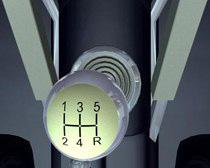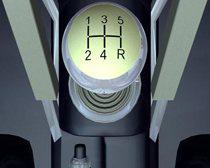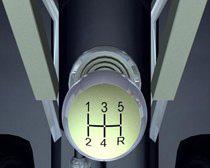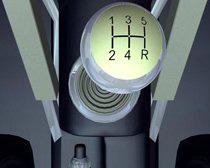How To Change Car Gears
Gears allow a car to be driven with the minimum strain on the engine. Modern cars usually have five forward and one reverse gear, although some cars now have a sixth forward which gives greater fuel economy when driving at higher speeds over longer distances.
To change gear in a car:
- Release the accelerator pedal and at the same time press the clutch pedal down.
- Remove your left hand from the steering wheel, cup it around the gear knob and move the lever gently but positively from one position to another.
- Return your left hand to the steering wheel.
- Release the clutch pedal slowly and simultaneously apply power by pressing down on the accelerator pedal.
Whilst changing gear you must always keep your eyes on the road. The sound of the engine can tell you when you need to change gear. As you accelerate the engine will come to sound whiny and take on a higher pitch. This is because the engine is reaching its limits for the gear you are in. When you hear this you should change up.
Remember:
- The low gears provide lots of acceleration but run out of steam before the vehicle is moving very quickly.
- The high gears provide the speed but not the acceleration.
For a smooth ride you should avoid “snatching” (changing gear with too much force). To make the gear change smoother, let the gearshift pause for a second as it crosses the neutral zone.
On your driving test the examiner will expect you to:
- Choose the right gear for the speed you need to travel at, and for the road conditions you face.
- Change gear smoothly, safely and under control.
- Return your hand to the steering wheel once you have changed gear.
- Don’t look at the gear lever while changing gear.
- Don’t coast with the clutch pedal down or the gear lever in neutral.
Block Changing
You don’t have to use the gears in exact sequence. Where appropriate, you can miss a gear. This is called block changing.
Say you are driving at 60mph but have to brake and slow the car to 20mph. Here you wouldn’t have to change down through the gears but could go from fifth to third, or even to second.
Likewise, you can block change up, while accelerating you could change from third into fifth, a method which helps save fuel. Block changes also reduces wear on the clutch as it is used less often.
Selecting a lower gear whilst accelerating
Lower gears provide greater power and acceleration. Sometimes you will need to change to a lower gear because you need a burst of power and acceleration, for example when overtaking.
The engine brake
When you remove your foot from the accelerator the engine automatically slows the car, this is known as the engine brake. In high gears this effect is hardly noticeable but in low gears the engine brake is much more noticeable and is an effective way of slowing the car.
Driving downhill
You should select a lower gear when driving downhill, so the engine brake helps to control your speed

First
The gear giving the greatest power but lowest speed. Used for moving off, manoeuvres and negotiating hazards.

Second
Used for slow speed situations such as roundabouts and junctions, for moving off downhill and for increasing speed after moving off.

Third
Used for driving uphill, through a hazard at speed and where a greater degree of power is needed than fourth will allow.

Fourth
Low power but the greatest speed range. Used for most driving situations at and over 30 mph where there are no hazard to negotiate.

Fifth
Lowest power, highest speed. Used for high speed cruising on dual carriageways, motorways and other such open roads.

Reverse
A high powered gear used for driving the vehicle backwards.

NEUTRAL
Disengages the engine from the wheels.
On your test, when changing gears, the examiner will expect you to:
- Use the controls smoothly and correctly
- Balance the accelerator and clutch to move away smoothly
- Accelerate evenly
- Avoid stalling the car
- Choose the right gear and change in good time before a hazard
- Brake gently and in good time
- Know how and when to apply the hand brake
